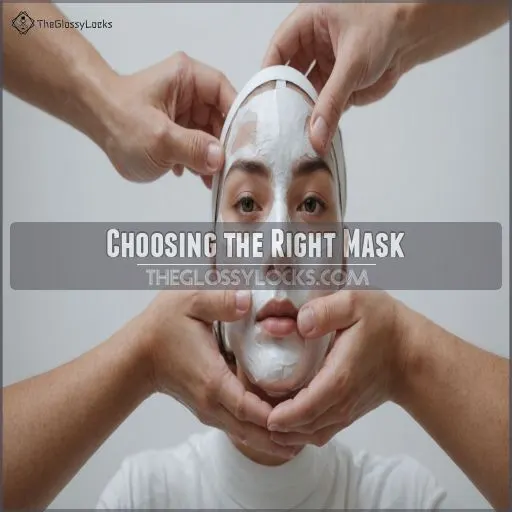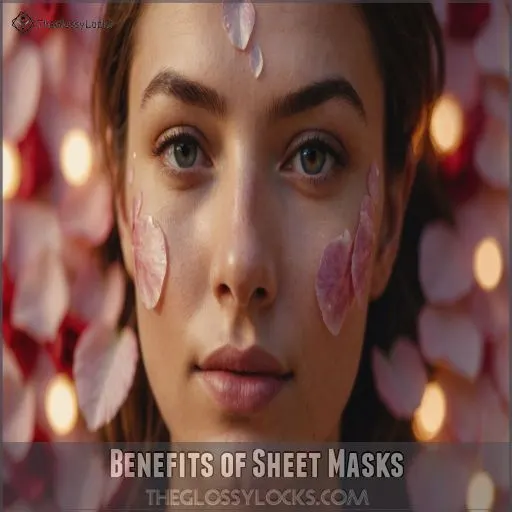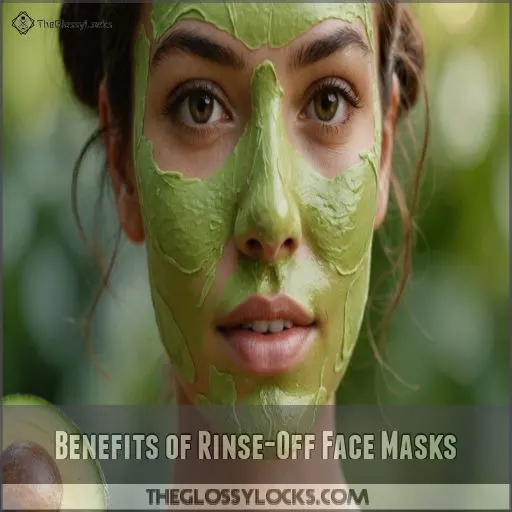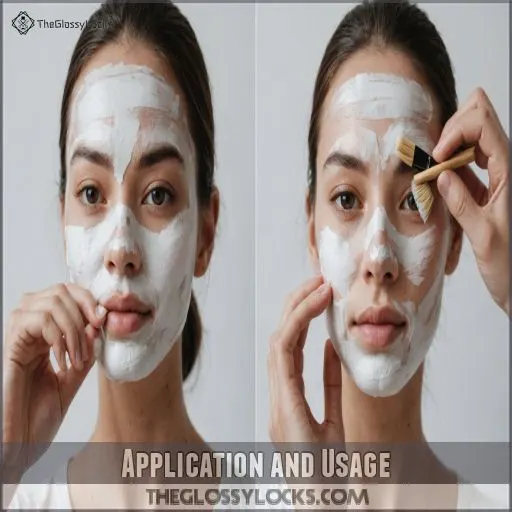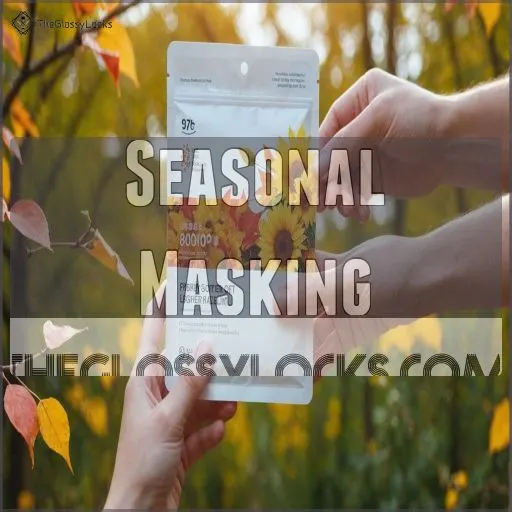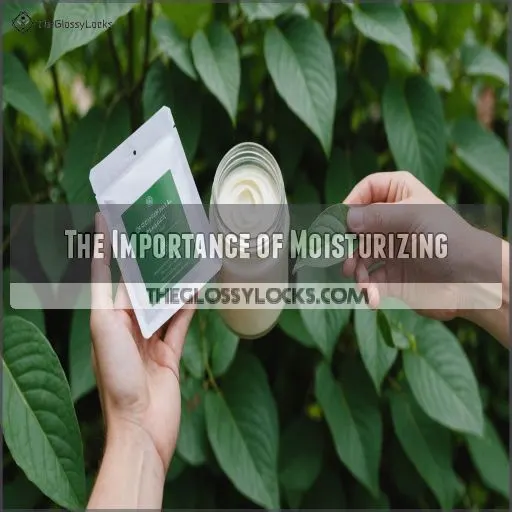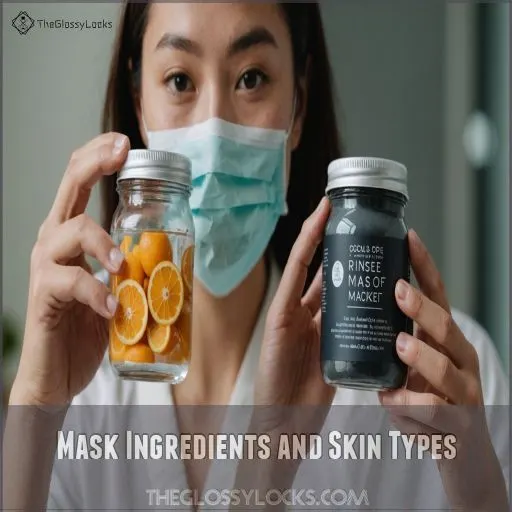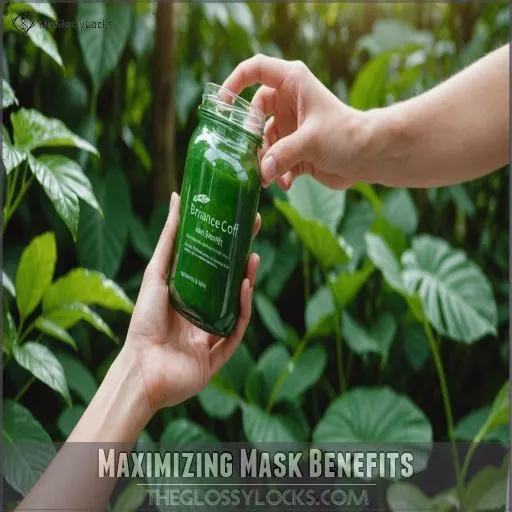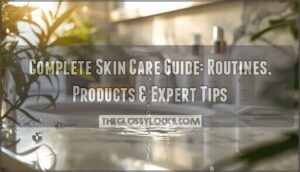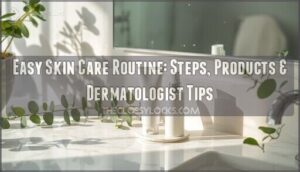This site is supported by our readers. We may earn a commission, at no cost to you, if you purchase through links.

Sheet masks are like a quick hydration hug for your face, delivering an instant boost of moisture and nutrients. They’re perfect for those "I need to look amazing in 20 minutes" moments.
On the flip side, rinse-off masks are the multitasking champions, offering deep cleansing, exfoliation, and targeted treatments. They’re your go-to for addressing specific skin concerns over time.
Both have their perks, but choosing between them is like picking between a gourmet meal and a delicious smoothie – it depends on what your skin’s craving! And just wait until you hear about the secret to maximizing their benefits…
Table Of Contents
- Key Takeaways
- Choosing the Right Mask
- Benefits of Sheet Masks
- Benefits of Rinse-Off Face Masks
- Application and Usage
- Common Mistakes to Avoid
- Seasonal Masking
- The Importance of Moisturizing
- Sheet Masks Vs Rinse-Off Face Masks
- Mask Ingredients and Skin Types
- Maximizing Mask Benefits
- Frequently Asked Questions (FAQs)
- Are sheet masks or peel-off masks better?
- Which is better, sheet mask or face mask?
- Should you rinse your face after a sheet mask?
- Is a wash off mask good?
- Are face masks safe during pregnancy?
- How often should reusable face masks be washed?
- Can face masks cause carbon dioxide buildup?
- Are homemade face masks effective for skincare?
- Do face masks interfere with breathing?
- Conclusion
Key Takeaways
- Sheet masks are like a quick hydration boost on a busy day; they’re perfect for those "I need to look amazing in 20 minutes" moments, making your skin feel like it’s had a refreshing drink of water.
- Rinse-off masks are your skin’s personal trainer, tackling deep cleansing and exfoliating, much like a spa day in a jar; they’re ideal when you want a thorough, targeted treatment.
- Your choice between sheet masks and rinse-offs should reflect your skin’s specific needs. Think of it like picking between a cozy blanket and a power workout—each has its own time and place.
- Adjust your mask routine with the seasons, like switching up your wardrobe: hydrate more in winter’s chill and go for active ingredients in summer for that sun-kissed glow.
Choosing the Right Mask
You’re faced with a sea of face masks, but which one’s right for you?
Let’s explore how to choose between skin type and rinse-off masks based on your desired results and lifestyle needs.
Considering Your Skin Type
Picking the right mask is all about your skin type.
Think of it as skin’s personal matchmaker.
Whether you’re dealing with:
- Dry skin that’s thirstier than a camel in the desert
- Oily skin that could fry an egg
- Sensitive skin that throws a tantrum at the slightest provocation
- Combination skin playing Jekyll and Hyde
- Acne-prone skin staging a rebellion
Your skin type will guide you to the perfect mask, be it a hydrating sheet mask or a deep-cleansing rinse-off face mask.
Desirable Results and Ingredients
Now that you’ve pinpointed your skin type, let’s focus on your skincare goals. Are you after that coveted glow, or battling pesky breakouts?
Your desired results will guide you to the right mask ingredients. For instance, if hydration’s your game, look for sheet masks packed with hyaluronic acid.
Battling oily skin? Clay-based rinse-off masks might be your new best friend (Source). Remember, the right ingredients are like a magic wand for your skin!
Time and Sensitivities
Pressed for time? Your skincare routine shouldn’t suffer.
Sheet masks offer quick, no-fuss application for busy bees, while rinse-off masks require a bit more effort but can multitask.
If you’ve got sensitive skin, opt for gentle sheet masks that soothe and hydrate without irritation. For those with allergies, carefully check ingredients to avoid potential reactions.
Remember, whether you’re a mask newbie or pro, listen to your skin’s needs and timing preferences.
Skin Concerns and Needs
Your skin’s unique needs should guide your mask choice.
For acne-prone or oily skin, opt for rinse-off clay masks to absorb excess oil and deeply cleanse.
If you’re battling dryness or sensitivity, sheet masks can provide a hydration boost without irritation.
Dealing with pigmentation or aging concerns? Look for masks with brightening ingredients or antioxidants.
Remember, your skin’s a canvas – choose the right mask to paint your perfect complexion!
Benefits of Sheet Masks
You’ve probably seen those sheet masks that make you look like a spooky ghost, but don’t let their appearance fool you.
These single-use wonders pack a powerful punch in terms of boosting your skin’s hydration and overall health.
They are known as single-use wonders and can improve skin health.
Hydration and Suppleness
Sheet masks are a hydration powerhouse for your skin.
They’re packed with moisture-boosting ingredients like hyaluronic acid and glycerin that quench thirsty skin cells.
When you apply one, it creates a barrier that locks in all that goodness, allowing your skin to drink up the hydrating serum.
The result? Plumper, more supple skin that feels refreshed and looks radiant. It’s like giving your face a tall glass of water!
Soothing Properties and Gentle Nature
While sheet masks excel at hydration, they’re also a gentle giant in the skincare world.
Their soft, textured fabric delivers a soothing touch to your skin, making them perfect for those with sensitive complexions.
Unlike some harsh rinse-off masks, sheet masks are designed to calm and cool, reducing irritation risks.
Think of them as a comforting hug for your face, packed with calming ingredients that pamper your skin without any rough treatment.
Nutrient-Rich Serum and Deep Hydration
With sheet masks, you’re treating your skin to a nutrient-rich serum that delivers deep hydration .
These masks are packed with powerful ingredients that penetrate your skin, offering a range of benefits:
- Intense moisture replenishment
- Anti-aging support with antioxidants
- Brightening effects for a radiant complexion
- Soothing properties for sensitive skin
Think of it as giving your face a revitalizing drink of water, leaving you with a dewy, plump look that’ll have everyone asking about your skincare secret.
Benefits of Rinse-Off Face Masks
Rinse-off face masks pack a powerful punch for improving your skin.
They’re not just great for exfoliating and brightening, but they also let you multitask.
Deep-cleaning your pores with ingredients like clay.
Exfoliating Agents and Multitasking
Rinse-off masks’ secret weapon? Exfoliating agents that multitask like pros.
These powerhouses slough off dead skin cells while tackling other skin concerns.
Whether you’re into DIY scrubs or chemical exfoliation, there’s a mask for you.
Gentle exfoliants like glycolic acid can work wonders in your weekly routine .
Think of these masks as your skin’s personal trainer, buffing away dullness and revealing your glow.
Ready to level up your skincare game?
Brightening and Cleansing Properties
Beyond exfoliation, rinse-off masks are powerful for brightening and cleansing. These multitasking marvels can give your skin a radiant boost while washing away impurities.
- Targeted brightening ingredients like vitamin C or niacinamide
- Deep cleansing action to unclog pores
- Instant glow-up for dull complexions
You’ll love how these masks leave your skin feeling squeaky clean and looking luminous. It’s like giving your face a mini spa day at home!
Deep Cleansing With Clay
Clay masks are the unsung heroes of deep cleansing. They’re like little vacuum cleaners for your pores, gently drawing out impurities and excess oil .
You’ll love how they leave your skin feeling fresh and renewed.
But here’s a pro tip: don’t let them dry completely. Once they start to feel tight, it’s time to rinse off. This way, you’ll get all the benefits without irritating your skin.
Application and Usage
You’ve picked your perfect mask, but now what?
Let’s explore how to apply sheet masks and rinse-off face masks properly.
Along with some tips on when and how often to use them for the best results.
Applying Sheet Masks
Applying sheet masks is a treat! Think of it as giving your face a relaxing hug. Here’s your quick guide to sheet mask bliss.
- Cleanse and tone your face first
- Unfold the mask carefully (no tearing!)
- Line it up with your features
- Smooth it onto your skin
- Relax and let the magic happen
Remember, sheet masks are like a spa day for your face – enjoy the moment!
Applying Rinse-Off Face Masks
Now let’s tackle rinse-off face masks. These bad boys come in various forms – creams, gels, mud, and clay.
Applying them is a breeze:
| Mask Type | Application Method | Tips |
|---|---|---|
| Cream/Gel | Fingertips, even layer | Avoid eyes and lips |
| Clay/Mud | Quarter-sized amount | Start at neck, work up |
| Bubble | Quarter-sized amount | Keep off eyes and lips |
Remember, most masks shouldn’t overstay their welcome – 20 minutes max, unless it’s an overnight mask.
Ready to rinse? Use lukewarm water and gentle fingers.
Frequency of Use and Timing
You’ve got your mask routine down, but how often should you indulge? Sheet masks can be your daily skin treat, slipping into your routine like a comfy pair of slippers.
For most other types of masks, such as rinse-off masks, they are more of a weekly affair.
Rinse-off masks are more of a weekly affair. For most cream and gel masks, aim for thrice-weekly pampering sessions.
Remember, your skin’s like a houseplant – don’t overwater it! Since doing the mask too much can lead to trouble your skin can’t handle, keep in mind that your skin’s like a houseplant
Common Mistakes to Avoid
You’ve got your mask routine down, but are you making these common mistakes?
Let’s explore some pitfalls to avoid when using sheet masks and rinse-off face masks, so you can get the most out of your skincare game.
Leaving Your Mask on Too Long
Many of us are guilty of leaving face masks on longer than recommended, thinking it’ll supercharge the benefits.
But hold your horses! Overindulging can backfire.
With clay masks, extended wear can strip away the good stuff along with impurities.
Sheet masks? They’ll start re-absorbing moisture from your skin, leaving it drier than before.
Stick to the suggested time to keep your skin happy and hydrated.
Not Cleansing Your Skin Beforehand
Skipping the cleanse before masking? That’s like trying to paint a masterpiece on a dirty canvas! Your skin’s a canvas, and cleansing is the primer.
Without it, you’re just trapping dirt and bacteria under your mask . This can lead to clogged pores and reduce product absorption.
Don’t let residue buildup sabotage your skincare efforts. Remember, a clean face is the first step to mask effectiveness and radiant skin!
Using the Wrong Mask for Your Skin Type
Now that you’ve got a clean canvas, let’s tackle another common face mask faux pas. Ever slapped on a mask only to end up with angry, irritated skin? Yep, you might be using the wrong mask for your skin type. It’s like trying to fit a square peg in a round hole – it just won’t work!
For oily skin, you need to choose a mask that can help control sebum production, like the best face mask for oily skin that contains ingredients such as clay and charcoal masks, which can help absorb excess oil and unclog pores. Regular use of the right mask can also reduce oiliness and prevent breakouts.
- Oily skin: Look for clay or charcoal masks
- Dry skin: Hydrating sheet masks are your BFF
- Sensitive skin: Soothing ingredients like aloe vera
- Combination skin: Multi-masking is the way to go
- Acne-prone skin: Opt for masks with salicylic acid
Seasonal Masking
Just like your wardrobe, your skincare routine needs a seasonal update too.
As the weather shifts, it’s time to rethink your masking game and give your skin exactly what it craves, whether that’s extra hydration in winter or a deep cleanse in summer, specifically a deep cleanse.
Adjusting Masks With the Seasons
Four seasons, four unique skincare needs.
Your skin’s requirements change with the weather, so why shouldn’t your mask routine? Adjusting your mask choices throughout the year can help you address seasonal skin concerns effectively.
As temperatures fluctuate, so does your skin’s sensitivity and hydration levels . By tailoring your mask ingredients to the season, you’ll keep your complexion happy year-round.
Remember, what works in winter mightn’t be ideal for summer, and that’s why it’s essential to make those adjustments to maintain a happy year-round complexion.
Hydrating Masks for Winter
Winter’s harsh winds and dry indoor heat can leave your skin feeling parched.
You’ll want to reach for hydrating masks that pack a moisture punch. Look for ingredients like hyaluronic acid, glycerin, and ceramides to quench your thirsty skin.
Sheet masks soaked in rich serums can be particularly effective, giving your face a boost of hydration and leaving it feeling refreshed and plump . Don’t forget to seal in that moisture with a nourishing cream!
Masks With Actives for Summer
Summer’s sizzle calls for a skincare shake-up. Swap your heavy winter masks for ones packed with active ingredients. These powerhouses can help you:
- Combat increased oil production
- Protect against sun damage
- Soothe heat-induced inflammation
- Brighten sun-kissed skin
Remember, your skin might be more sensitive in summer. After masking, don’t forget to slather on that SPF. It’s your best defense against those sneaky UV rays trying to crash your summer glow party.
The Importance of Moisturizing
You’ve just treated your skin to a luxurious mask session, but don’t stop there.
Moisturizing after your mask is the key final step that locks in all those skin-loving benefits and keeps your complexion hydrated and happy.
Locking in Moisture and Preventing Evaporation
After pampering your skin with a mask, don’t let all that goodness evaporate!
Think of your skin as a sponge – you’ve just soaked it in nutrients, now it’s time to seal the deal.
Moisturizing is your secret weapon to lock in hydration and maintain that coveted barrier function.
By applying a moisturizer rich in humectants and occlusives, you’re basically putting a protective shield over your skin, keeping all those beneficial ingredients where they belong.
Complementing Mask Ingredients With Moisturizer
Imagine your skin as a sponge, readily soaking up all the goodness from your mask.
But here’s the kicker: to truly lock in those benefits, you’ve got to seal the deal with a moisturizer.
Think of it as the perfect dance partner for your mask ingredients. By pairing the right moisturizer with your mask, you’re creating a skincare dream team that’ll have your complexion singing with joy.
This approach will yield the best results, as you’re essentially allowing your skin to fully absorb the mask’s ingredients, and then seal the deal with a moisturizer.
Sheet Masks Vs Rinse-Off Face Masks
Wondering whether to reach for a sheet mask or a rinse-off face mask?
You’re not alone in this skincare dilemma.
Let’s compare these two popular mask types to help you choose the right one for your unique skin needs and lifestyle.
Key Differences and Similarities
Now that we’ve locked in moisture, let’s explore the key differences between sheet masks and rinse-off face masks.
These two skincare powerhouses have distinct characteristics:
- Application: Sheet masks are pre-soaked fabrics, while rinse-off masks are creams or clays you apply directly.
- Duration: Sheet masks typically stay on for 15-20 minutes, rinse-off masks can vary.
- Removal: Peel off sheet masks, wash off rinse-off masks.
- Ingredients: Sheet masks focus on hydration, rinse-off masks often target specific skin concerns.
Choosing the Right Mask for Your Needs
Choosing the right mask boils down to your skin’s needs and your lifestyle. Let’s break it down:
| Factor | Sheet Masks | Rinse-Off Masks |
|---|---|---|
| Time | 20+ minutes | 10-15 minutes |
| Mess | Low | High |
| Travel | Easy | Challenging |
| Hydration | Intense | Moderate |
| Exfoliation | Minimal | Often included |
Sheet masks are your go-to for a quick hydration boost, while rinse-off masks are perfect for deep cleansing or exfoliation. Remember, it’s not about which one’s better – it’s about what your skin craves!
Mask Ingredients and Skin Types
You’re not alone if you’ve ever stood in front of a wall of face masks, wondering which one’s right for your skin.
Whether you’ve got dry, oily, or sensitive skin, there’s a mask out there with ingredients made for your needs.
Let’s explore how to find your perfect match.
Hydrating Ingredients for Dry Skin
Dry skin thirsts for hydration like a desert longing for rain. A rich beard conditioner with shea butter and argan oil keeps skin hydrated. When choosing face masks for parched skin, look for these powerhouse ingredients:
- Hyaluronic acid: A moisture magnet that plumps skin
- Ceramides: Strengthen the skin barrier
- Glycerin: Attracts and locks in moisture
- Shea butter: Nourishes with fatty acids
These ingredients work together to quench your skin’s thirst, leaving it feeling soft, supple, and refreshed. Remember, hydrated skin is happy skin!
Exfoliating Ingredients for Oily Skin
Oily skin warriors, rejoice! Your face’s natural oil slick is no match for these exfoliating powerhouses.
Glycolic acid, an AHA superstar, sloughs off dead skin cells, revealing a brighter complexion .
Its partner in grime, salicylic acid (BHA), dives deep into pores to banish bacteria and dirt.
Don’t forget fruit enzymes and clay masks – they’re like a vacuum cleaner for your face, sucking up excess oil and leaving you fresh-faced.
Soothing Ingredients for Sensitive Skin
When your skin’s throwing a tantrum, it’s time to bring in the big guns.
Sensitive skin craves gentle TLC, so look for masks packed with soothing superstars like aloe vera, chamomile, and oat . These ingredients are like a cozy blanket for your face, calming redness and irritation.
Green tea and calendula are also skin-soothing heroes, helping to dial down inflammation and leave you feeling refreshed.
Remember, gentle is the name of the game here, with soothing superstars and a focus on calming redness and irritation.
Maximizing Mask Benefits
You’ve got your sheet masks and rinse-off masks, but are you getting the most out of them?
Let’s explore how to customize your mask routine and monitor your progress to truly maximize those skincare benefits.
Customizing Your Mask Routine
Now that you’re familiar with different mask types and ingredients, it’s time to tailor your routine.
Mix things up by alternating between sheet masks for hydration and rinse-off masks for deep cleansing.
During winter, amp up the moisture with hydrating masks, while summer calls for masks with active ingredients to combat excess oil.
Don’t be afraid to get creative – try layering masks or whipping up DIY concoctions to address your unique skin needs.
Monitoring Progress and Adjusting Your Routine
When it comes to skincare, tracking your progress is key to achieving your skin goals.
As you start your mask journey, remember to:
- Take before and after photos
- Keep a skincare diary
- Monitor how your skin feels post-mask
By paying attention to these details, you’ll be able to fine-tune your routine and make the most of your masks.
Don’t be afraid to tweak your regimen – your skin’s needs may change with the seasons (Source).
Frequently Asked Questions (FAQs)
Are sheet masks or peel-off masks better?
Both have benefits, but it depends on your skin’s needs.
Sheet masks excel at hydration and soothing , while peel-off masks focus on exfoliation and deep cleansing.
Consider your skincare goals and routine to choose the best option for you.
Which is better, sheet mask or face mask?
To mask or not to mask? That’s the skincare question!
Sheet masks offer quick hydration and convenience, while face masks provide deeper cleansing and targeted treatments.
Your choice depends on your skin’s needs and your lifestyle (Source).
Should you rinse your face after a sheet mask?
Don’t rinse after a sheet mask!
Let the essence work its magic.
Gently pat any remaining product into your skin for maximum benefits.
It’s like leaving on a super-charged moisturizer – your skin will thank you!
Is a wash off mask good?
Ah, the eternal face mask dilemma!
You bet wash-off masks are good.
They’re like a spa day for your pores, offering deep cleansing and hydration.
You’ll control application, target specific skin concerns, and rinse away to reveal glowing skin .
Are face masks safe during pregnancy?
Most face masks are safe during pregnancy.
Avoid using face masks with retinoids, hydroquinone, and high-dose salicylic acid.
Instead, use face masks with gentle ingredients such as vitamin C, benzoyl peroxide, and glycolic acid for a pregnancy-safe glow.
How often should reusable face masks be washed?
Frequent face mask freshening fortifies your defenses!
You should wash your reusable mask daily after use . It’s a simple safety step that’ll keep you comfy and protected.
Plus, you’ll dodge those dreaded mask-ne breakouts and stay comfy and protected.
Can face masks cause carbon dioxide buildup?
No need to worry – face masks won’t cause a dangerous buildup of carbon dioxide.
The gas easily passes through the mask material.
Just focus on staying safe and healthy by wearing your mask properly.
Are homemade face masks effective for skincare?
Crafting face masks at home can work wonders for your skin!
Use skin-friendly ingredients like oatmeal or honey to nourish and soothe. Just skip lemon juice or cinnamon to avoid irritation.
Start making your own face masks!
Do face masks interfere with breathing?
While face masks can make you feel uncomfortable or short of breath, they don’t actually reduce oxygen levels.
If breathing issues arise, try finding a more breathable mask or take short breaks when safe to do so.
Conclusion
Choosing between sheet masks and rinse-off face masks is like deciding if you’d prefer a quick spa day or a deep therapy session.
Both have unique benefits: sheet masks offer instant hydration, like a quick pick-me-up, while rinse-off masks provide exfoliation and deep cleansing, akin to a gourmet meal.
It’s all about your skin’s cravings and needs. By understanding their roles, you can maximize your skincare routine and truly indulge your skin.
What’s your skin’s next craving in this skincare showdown?

